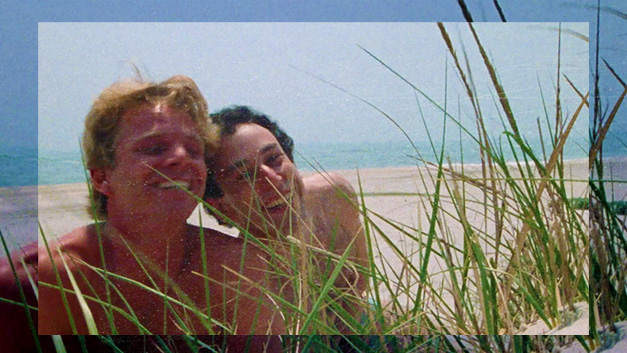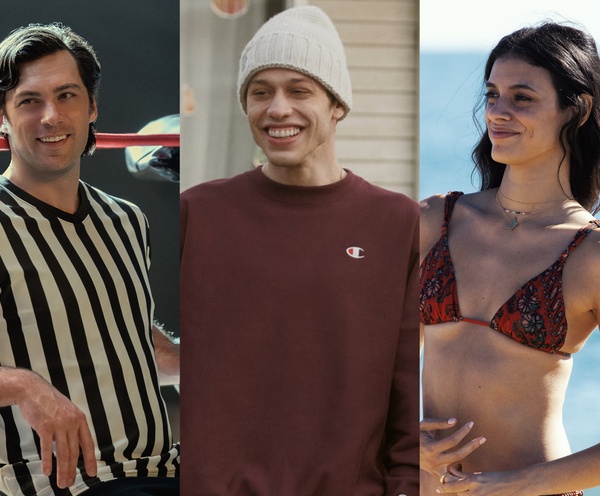
If you looked to the 1980s for representation of the HIV/AIDS epidemic on mainstream screens anywhere, you’d be staring into a void.
Hollywood, much like the reigning political administration of the time, ignored the crisis as it grew that decade — and certainly did not know what to do with it once ignorance was no longer an option. It wasn’t until Rock Hudson, once a glimmering fawned-upon pillar of quote-unquote masculinity, collapsed in the summer of 1985 and died that fall from AIDS complications that the film industry was finally forced to respond at all.
That same year, just a few months before Hudson’s death, porn-director-turned-activist filmmaker Arthur J. Bressan Jr. released the first narrative theatrical feature devoted to the gay plague that the likes of Reagan and Thatcher otherwise preferred to keep far away from legislation and policy.
Bressan died two years later from his own complications from AIDS, but “Buddies” remains a microbudget time capsule of how gay storytellers tried to approach the topic of the demise happening around and to them. It’s a no-budget offering, to be sure, centered on a New York City AIDS patient convalescing in a hospital bed (Robert, played by Geoff Edholm) who’s assigned a “buddy” (David, played by David Schachter) to provide companionship in his final hours. David is in a mostly monogamous relationship that’s made him profoundly naïve to the destructive force of AIDS. Robert, meanwhile, is succumbing to Karposi sarcoma lesions, ruing a lost lover who left him once the disease became an all too intrusive reality in their relationship.
There was some recognition of AIDS in Hollywood — of which “Buddies” was decidedly not part of — in 1994 when Tom Hanks won the Best Actor Oscar for portraying a gay man dying from the disease in Jonathan Demme’s “Philadelphia.” But here was a straight actor playing that role, being directed by a straight filmmaker, in a movie about a gay man who had to be saved by another straight man, Hanks’ character’s personal injury attorney played by Denzel Washington. (Hanks has since said he wouldn’t star in the film today.)
“Buddies” tells a different story. It’s made by a gay filmmaker who cast gay men in the leading roles. Bressan had, up until then, been making mostly adult movies — one of which, “Passing Strangers,” actually plays in “Buddies” on a TV screen in Robert’s hospital room as he has what is probably his last orgasm — but with everyone dying around him, “Buddies” marked an opportunity to speak up. (That same year, only the made-for-TV “An Early Frost,” starring Aidan Quinn, even touched on the topic albeit in a glossy NBC package.)
While Geoff Edholm and Arthur Bressan died not long after the movie’s brief stint in arthouses and at festivals in the early fall of 1985, star David Schachter, now an Associate Dean of Student Affairs at New York University’s Wagner School of Public Service, was unscathed by AIDS. Here, he shares his story about the making of “Buddies” with IndieWire.
The following interview has been edited and condensed for clarity.
IndieWire: As this was really the first theatrical film to deal with AIDS, do you still get contacted about “Buddies” often even 40 years later?
David Schachter: It’s had a mini-resurgence actually since it was restored in 2018. I’ve done a handful of interviews. It’s always so strange for me to relive that period. And I’m pretty honored to be a part of an artifact that captures a particular moment in time. A horrible time in America. So it’s with a little bit of pride and also a lot of poignancy and sadness that I’ve done a handful of these.
Arthur died in 1987, two years after “Buddies” briefly appeared in arthouse theaters and festivals. What was your relationship to him, and how did you become involved to begin with?
In 1979, I was finishing my freshman year of college at NYU. I was a drama major, and we were cruising each other, we may have been on Christopher Street. We went home, and we had a pretty hot on-and-off summer, and then things cooled off in the fall, and we remained very close friends afterwards. I was an actor. He was mostly a pornographer.
In the early ’80s, he was making a film called “Abuse,” which was one of his first narrative films, non-adult films, and asked if I could get a bunch of my friends together from NYU to play students in a film class, which I did and I wound up on the editing room floor. But in 1985, Artie gave me a call in February and said, “I am going to make a film about AIDS, and I want to know if you’d be interested in playing the buddy to the person with AIDS in the film.” I got the script, read it twice, met Geoff, we rehearsed in Artie’s apartment for two weeks. We shot the film in nine days. All the hospital scenes in chronological order. Artie edited it in his living room, and it premiered at the Castro Theatre in San Francisco on September 12.
What was your companionship to the movie’s release like? There was certainly fervor at the time around it for being the first independent feature about AIDS.
It was my first time in San Francisco … it was sold out [at the Castro Theatre], and it was a pretty wild reception. Artie spoke at the premiere, and he spoke very honestly about the devastation that the disease was having on the community and the misinformation and disinformation and how so many of his friends and lovers and colleagues were just coming down with symptoms and dying.
At this time, the urgency was pretty incredible. There was no test for HIV at the time the movie came out. The only way you knew you had it was you had symptoms. You had thrush on your tongue, night sweats, you might have Kaposi sarcoma, and maybe you were losing weight drastically, and that was it. The need for treatment, awareness, compassion was something Artie felt was urgent, and he really wanted to make the film and get it out very quickly.
After San Francisco, it played Film Forum in New York. In general, the straight press was somewhat kind if not fully understanding of the movie, and the gay press was much more welcoming and appreciative and frankly devastated by what they were seeing on film.
Just a few months after “Buddies,” there was the made-for-TV feature “An Early Frost” that perhaps put AIDS in a more palatable package for mainstream audiences.
It was incredibly well-received by critics and I think it was very popular with viewers, but it was a more sanitized version of the crisis, and it had a lot of focus that the impact the main characters coming out and then coming out with AIDS had on the family, the parents, as opposed to focusing on a much more gay-specific perspective.
I was born in 1990, so by the time I came out, my parents were still of the mindset of, “Well, you’re going to get AIDS and die.” Because that’s what media and that’s what politicians were telling them.
The policies and the bigotry were also pretty apparent. There were the leaders of the Christian right movement and the moral majority claiming AIDS was God’s revenge against homosexuals. There were many people who believed that, and that’s where they got their information. It was pretty abusive and not unusual for gay men in general let alone people with HIV/AIDS to be stigmatized. In 1985, President Reagan had yet to mention AIDS in a policy speech once. So all of the information and the care happening was grassroots.
What was your reaction to the news of Rock Hudson’s illness and death? He died not long after “Buddies” came out.
Rock Hudson collapsed in a hotel lobby in Paris the summer that Artie was editing “Buddies.” Rock Hudson was a beautiful man and one could see in the photos of him the devastation that AIDS had wracked on his body. It was an unfortunate way for him to come out. He certainly didn’t do it of his own volition. There were kissing clauses after this happened, especially in television series and nighttime soaps, where many people put “no kissing” clauses in their contract, for fear of contracting the virus that way. It did not necessarily open up any doors or floodgates for care or concern. Certainly, [his death] wasn’t perceived in that way by the vast majority of people.
How would you characterize the “Buddies” shoot?
It was pretty intense. You know, I call it guerilla filmmaking. We shot the entire film in nine days. We shot all the hospital scenes in three days in chronological order, and you know, it was on 16-millimeter film. We did mostly one or two takes. We didn’t get to see dailies or rushes or anything. It was just like, shoot it, boom, done.
Geoff and I, having known each other previously and through this process, became very close and had to really trust each other to take care of each other. Not only in the shooting, but in between takes. And it was much harder for Geoff than it was for me. Neither Geoff nor Artie knew if they were HIV positive at that time or would get it. Geoff shared with me that he’d hoped by taking his part, that he would be spared, and Artie said he named the character that I played, David, with me in mind to, what he termed, condemn me to good health. It’s very intense.



